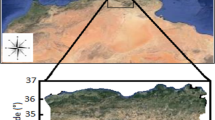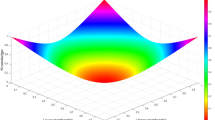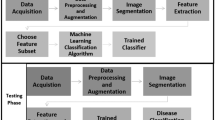Abstract
A modified counter propagation network model and an extended self-organizing map model have the same three-layer network architecture while employing slightly different learning rules. Their network architecture comprises an input layer, a Kohonen layer and an output layer. The neurons between two neighboring layers are fully connected and the neighboring neurons within the Kohonen layer also have neighborhood connections. The modified counter propagation network model employs the Kohonen algorithm to train the Kohonen layer while using the Widrow–Hoff rule to train the output layer. However, the extended self-organizing map model applies a modified Kohonen’s learning rule to train both the Kohonen layer and the output layer. This paper compares the performances of these two models in supervised classification of remotely sensed data. The training results show that compared to the extended self-organizing map model, the modified counter propagation model has faster learning speed but larger output errors. The classification results indicate that the extended self-organizing map model has a faster classification speed and a much higher classification precision than the modified counter propagation model.
Similar content being viewed by others
References
Carpenter GA, Gjaja MN, Gopal S, Woodcock CE (1997) ART neural networks for remote sensing: vegetation classification from landsat TM and terrain data. IEEE Trans Geosci Remote Sens 35(2):308–322
Deboeck GJ (1998) Financial applications of self-organizing maps. Electron Newslett Am Heuristics Inc, p 7
DeSieno D (1988) Adding a conscience to competitive learning. IEEE international conference on neural networks, San Diego, 24–27 July 1988, vol 1, pp 117–224
Dharia A, Adeli H (2003) Neural network model for rapid forecasting of freeway link travel time. Eng Appl Artif Intell 16(4):607–613
Grossberg S (1980) How does the brain build cognitive code? Psychol Rev 87(1):1–51
Juang SC, Tarng YS, Lii HR (1998) A comparison between the back-propagation and counter-propagation networks in the modeling of the TIG welding process. J Mater Process Technol 75(1):54–62
Kohonen T (1981) Automatic formation of topological maps of patterns in self-organizing systems. In: Oja E, Simula O (eds) Proceedings of the second Scandinavian conference on image analysis. Espoo, Helsinki, p 484
Kohonen T (1982) Self-organized formation of topologically correct feature maps. Biol Cybern 43(1):59–69
Kohonen T (1990) The self-organizing map. Proc IEEE 78(9):1464–1480
Kohonen T (2001) Self-organizing maps. 3rd edn. Springer, New York
Merényi E (1998) Self-organizing ANNs for planetary surface composition research. In: Verleysen M (ed) Proceedings of European symposium on artificial neural networks. ESANN98, Bruges, p 432
Nie J, Loh AP, Hang CC (1996) Modeling pH neutralization processes using fuzzy-neural approaches. Fuzzy Sets Syst 78(1):5–22
Nielsen HR (1987) Counter propagation networks. Appl Opt 26:4979–4984
Penn BS (2002). Using self-organizing maps for anomaly detection in hyperspectral imagery. In: Proceedings of 2002 IEEE aerospace conference, Big Sky, MT, 9–16 March, vol 3, no 10, pp 1531–1535
Salajegheh E, Gholizadeh S (2005) Optimum design of structures by an improved genetic algorithm using neural networks. Adv Eng Softw 36(4):757–767
Vesanto J, Alhoniemi E (2000) Clustering of the self-organizing map. IEEE Trans Neural Netw 11(3):586–600
Villman T, Merényi E (2001) Extensions and modifications of the Kohonen-SOM and applications in remote sensing image analysis in self-organizing maps. In Sieffert U, Jain LC (eds) Recent advances and applications. Springer, Berlin, p 278
Vracko M, Mills D, Basak SC (2004) Structure-mutagenicity modelling using counter propagation neural networks. Environ Toxicol Pharmacol 16(1):25–36
Zhang Z, Wang Y, Tao R, Zhou S (2002) An improved self-organizing CPN-based fuzzy system with adaptive back-propagation algorithm. Fuzzy Sets Syst 130(2):227–236
Zupan J, Novič M, Gasteiger J (1995) Neural networks with counter-propagation learning strategy used for modeling. Chemom Intell Lab Syst 27(1):175–187
Author information
Authors and Affiliations
Corresponding author
Rights and permissions
About this article
Cite this article
Chen, Y., Pazner, M.I. & Wu, W. A Comparison between a Modified Counter Propagation Network and an Extended Self-Organizing Map in Remotely Sensed Data Classification. Math Geol 39, 559–574 (2007). https://doi.org/10.1007/s11004-007-9115-7
Received:
Accepted:
Published:
Issue Date:
DOI: https://doi.org/10.1007/s11004-007-9115-7




